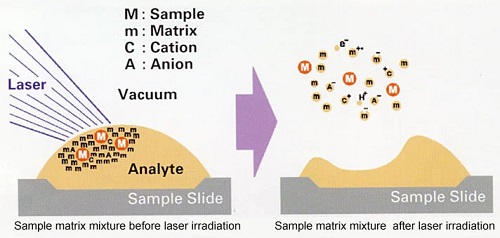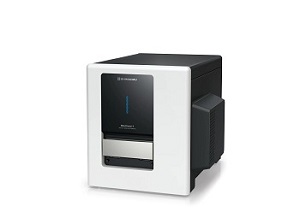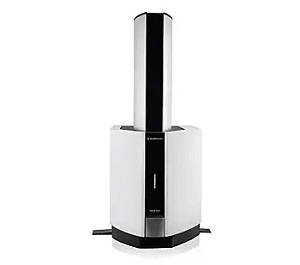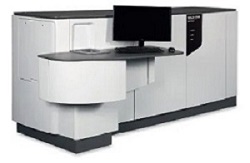MALDI-TOF Mass Spectrometer Comparison
MALDI-TOF MS Comparison
This page provides a quick overview of 7 models of MALDI/MALDI-TOF mass spectrometers. Choose the model that best suits your analysis needs from the compact digital ion trap MS for on-the-spot analysis, the benchtop MALDI-TOF MS for routine analysis to the research grade MALDI TOF/TOF MS for a diverse range of applications.
Contents
1. Summary of Product Features
“Minimum” footprint
With its simple configuration and compact size, it is possible to install the MALDImini-1 in places where mass
analysis devices could not previously be used.
“Minimum” time
Miniaturization allows rapid, "on-the-spot" analysis and simplifies data acquisition.
“Minimum” sample volume
Complex structural analysis can be performed even with sub-µL sample volumes.
Best-in-class sensitivity and resolution
Easily detect analytes for your application
Quickest to your result
Fast (200 Hz) solid-state laser and fast sample instruction using load-lock chamber
Small footprint/benchtop design
The smallest instrument in its class – saves your valuable laboratory space
Solutions for all your applications
Food & cosmetics, teaching & research labs, regulatory & manufacturing Labs
High throughput and high resolution
True 2kHz acquisition speed in MS and MS/MS modes and high MS/MS resolution (10,000) via ASDF
Hyper-MS2, a new benchmark in MS/MS acquisition
Combining core technologies patented and exclusive to Shimadzu
Ultimate applications performance
Flexibly accommodate a wide range of analysis needs
Highly flexible research-grade MALDI TOF/TOF mass spectrometer
From high energy MS/MS of proteomics and other biological and organic samples to uncompromised analysis of high mass intact proteins
High performance in a robust and flexible design
Uncompromised linear mode performance for high mass analysis
Application-centric solutions
Provides total support for protein identification, LC-MALDI and biomarker discovery
Specifications
| Measurement type |
Digital Ion Trap
|
Linear-TOF | Linear-TOF | Linear/Reflectron-TOF Reflectron-TOF/TOF |
Linear/Reflectron-TOF | Linear/Reflectron-TOF Reflectron-TOF/TOF |
Linear/Reflectron-TOF Reflectron-TOF/TOF |
|---|---|---|---|---|---|---|---|
| Measured ion |
Positive
|
Positive |
Positive and Negative
|
Positive and Negative
|
Positive and Negative | Positive and Negative | Positive and Negative |
| Mass range (m/z) | 650-70,000 |
1-500,000
(Linear mode) |
1-500,000
(Linear mode) |
1-500,000 (Linear mode) 1-80,000 (Reflectron mode) |
1-500,000 (Linear mode) |
1-500,000 (Linear mode) 1-80,000 (Reflectron mode) |
1-500,000 (Linear mode) 1-80,000 (Reflectron mode) |
| MS/MS function | CID up to MS3 |
-
|
-
|
CID/PSD (Post Source Decay) |
- | Post Source Decay (PSD) |
CID |
| Mass Resolution | > 4,000 |
> 5,000
|
> 5,000
|
> 6,000
(Linear mode) > 25,000 (Reflectron mode) > 10,000 (MS/MS) |
> 5,000 | > 5,000 (Linear mode) > 15,000 (Reflectron mode) |
> 5,000 (Linear mode) > 20,000 (Reflectron mode) |
| Mass accuracy | External : 200 ppm |
Internal : 20 ppm
External : 200 ppm |
Internal : 20 ppm
External : 200 ppm |
Internal : 20 ppm
(Refrectron mode) 50 ppm (Linear mode) |
Internal : <30 ppm External: <200 ppm |
Internal : 10 ppm (Refrectron mode) 30 ppm (Linear mode) |
Internal : 5 ppm (Refrectron mode) 30 ppm (Linear mode) |
| Throughput | 0.3, 0.6 spectrum/s (Depend on mass range and scan speed) |
50, 100, 200Hz (Variable)
|
50, 100, 200Hz (Variable)
|
1 - 2,000 Hz (Variable) | 1 - 50 Hz (Variable) | 1 - 50 Hz (Variable) |
1 - 50 Hz (Variable)
|
| Dimensions/ Weight | W309 × D385 × H320 mm 25 kg |
W600 × D745
× H1,055 mm 86 kg |
W600 × D745
× H1,055 mm 92 kg |
W2,834 × D1,276 × H1,182 mm 875 kg |
W700 × D850 × H1,920 mm 330 kg |
W700 × D850 × H1,920 mm 345 kg |
W700 × D850
× H1,920 mm 375 kg |
| Type | Benchtop |
Benchtop
|
Benchtop
|
Floor standing
|
Floor standing |
Floor standing
|
Floor standing
|
Applications
| Protain identification |
 |
||||||
|---|---|---|---|---|---|---|---|
| Glycans/ Glycopeptides investicgation |
 |
|
|
||||
| Synthetic peptides and Proteins |
 |
 |
|||||
| Screening analysis |
 |
 |
|||||
| Cell culture |
 |
 |
 |
||||
| Food/ Cosmetics |
 |
 |
 |
||||
| Small molecules |
 |
 |
 |
||||
| QA/QC |
 |
 |
 |
||||
| Polymer analysis |
 |
 |
 |
 |
 |
||
| Oligonucleotide/ Primer analysis |
 |
 |
 |
||||
| Biomarker discovery |
 |
||||||
| Proteomics |
 |
||||||
| High-energy MS/MS of proteomics and other biological /Organic samples |
 |
 |
|||||
| High-mass intact proteins |
 |
 |
|||||
| MS Imaging |
 |
||||||
| High thoughput screening |
 |
||||||
3. Principle of MADI-TOFMS

What is MALDI?
MALDI is the abbreviation for "Matrix Assisted Laser Desorption/Ionization."
The sample for MALDI is uniformly mixed in a large quantity of matrix…






